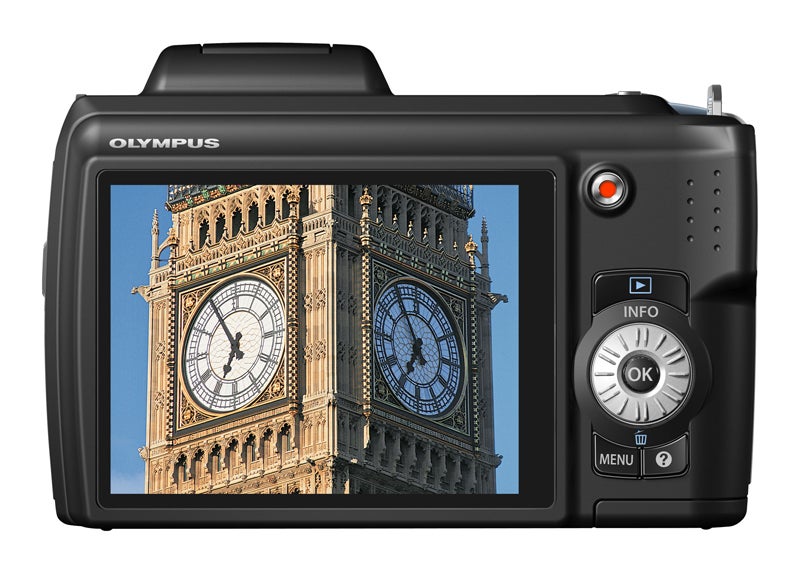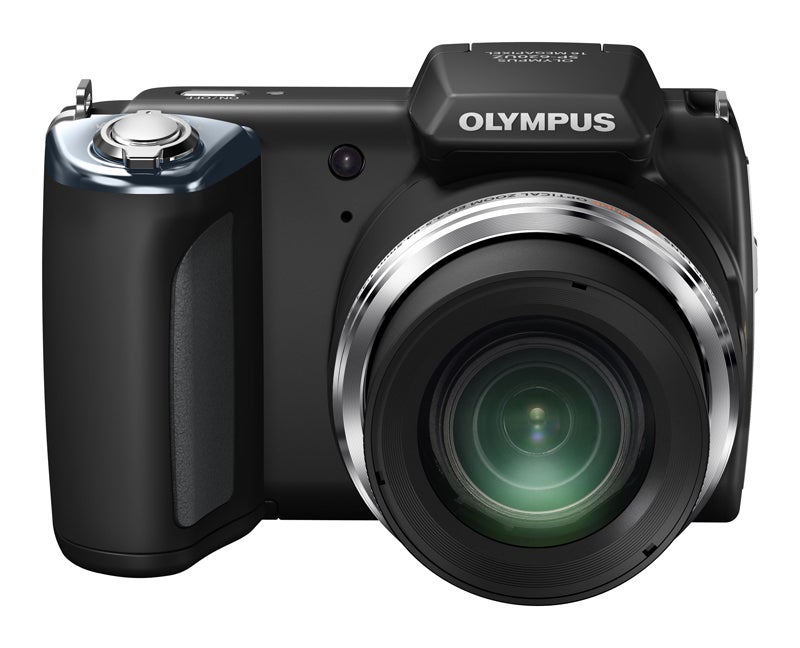Olympus SP-620UZ Review
Olympus SP-620UZ Review
Olympus’ update of the SP-610UZ has arrived as the SP-620UZ and it arrives boasting a 16-megapixel sensor, a 21x optical 'ultra-zoom' lens and other treats. Find out how it fares in this, its full WDC test?

Verdict
Pros
- Price tag, general performance, image quality, features, ease of use
Cons
- Build quality, design flaws
Key Specifications
- Review Price: £180
Looking back at how digital camera development has progressed years, if you’d said to me only five years ago, you’d be able to buy a 16-megapixel consumer compact with that resolution and a 21x zoom lens for under £200 I would have simply laughed.

Well, 10-years into the SP range, you can do just that and the £179.99 Olympus’ SP-620UZ marks the company’s latest iteration of the SP range and is an affordable entry into the world of ultra-zoom compact cameras it is. Succeeding last year’s 14-megapixel SP-610UZ the SP-620UZ features a series of updates that sit alongside the 16-megapixel, 1/2.3-inch CCD sensor and its remarkable 21x ultra-zoom lens. Olympus’ TruePic III+ image processor and a range of ‘Magic Filters’ plus a new 3D image feature able to combine two separate photos into a single 3D image.
The 720P HD video recording functionality from the older SP-610UZ remains along with a mini HDMI port for connection to an HDTV, though disappointingly, that HDMI cable needed to do just that is an optional extra. Four AA batteries, a set of which is included with the camera, power the SP-620UZ.
Olympus SP-620UZ Review – Features
The main appeal of cameras such as the SP-620UZ is their ability to capture everything from a wide landscape, fleeting wildlife on to stunning close ups thanks to the camera’s super close up mode. In other words, such cameras are a photographic jack-of-all-trades.
There are black and silver liveried variants available with the body, unlike many cameras, relatively free from button and control clutter making it’s mini DSLR-alike design less daunting than more expensive, similar models on the market.
In essence then, the SP-620UZ is akin to a ‘normal’ compact but with that massive lens stuck onto the front; build is rather plastic for my liking, particularly the battery and SD/SDHC/SDXC card port under the nicely sculpted hand grip, which simply feels as if it’ll break with frequent use.
And as it’s the place where the four AA cells are housed and its memory card, frequent use is exactly what it’ll get.
Along with an RRP of £179.99 (you’d expect to pay around £160 on the high street) the 21x optical zoom is undoubtedly the other star attraction of the SP-620 its maximum F/3.1 aperture lens gives the 35mm equivalent focal length of 25-525mm yet with an impressively close, closest focus distance of just 10cm from your subject, in the macro mode.
Compared with SP-610’s 28-616mm focal range reach, the 620’s lens has a wider starting focal length and shorter full zoom end, the wider wide ‘end’ is arguably more useful than that of its predecessor, so it’s a compromise I feel is worth paying. As before, the (still mammoth) lens is supported by dual image stabilization, something that’s very much required at those longer focal lengths, even in brighter conditions.
It’s also still worth bearing in mind however, if it’s svelte lines with longer focal lengths you want, many of today’s compact travel zooms offer up to 20x zooms in portable proportions too. As you’d expect from camera in 2012, HD video recording can be shot alongside stills via dedicated button positioned top right on the back plate, though I found this position could be easily and accidentally activated while carrying the camera. When it is on you can shoot a maximum 1280×720-pixels clips with sound.
The accidental activation of video recording is partly down to the camera’s small size as there’s little room to rest your fingers elsewhere and so, once again, there’s a compromise to be paid for the benefit of a large lens in a relatively small body. Despite this, the 620 features what Olympus calls “Multi-motion Movie IS” simply put an intelligent image stabilization system designed to help improve movie results when filming on the move, so some of our unintended footage may still be sharp and stable, even if it is just an unintended short sequence of your feet!
As is seemingly the norm for digital compacts today, the 620 does without an optical viewfinder (or electronic one for that matter) relying on its fixed, 3-inch LCD, which dominates the back of the camera. The screen’s resolution is a lowly 230k pixels; very modest by today’s standards and more typical of an inexpensive, £100 snapper.
One of the options on the SP-620 that help to demarcate this camera from the madding crowd are 11 “Magic” effects filters, similar to and operating in a similar way as Olympus’ “art” filter system on it’s Pen models, for example. These are housed within the camera’s shooting options menu reached by pressing the ‘OK’ button on the back plate and then scrolling left and right through the shooting modes that can be browsed on the right side of the display.
The options include Punk, Pop Art, Pin Hole, Drawing, Fish Eye, Soft Focus, Sparkle and Watercolour effects; Miniature, Reflection and a fun ‘Fragmented’ filter complete the options. All but Fragmented and Sparkle can be used on video too. All are fun and you get previews (albeit barely large enough to be of use) displayed before you pick the one you want.
Alongside the Magic Filters are the 3D photo and a Panorama mode and the more usual array of 17 Scene modes such as Sport, Sunset, Fireworks and Portrait, Pet (with separate settings for dog and cat!) and Beauty and Landscape forming some of the 15 options to hand.
The Panorama mode joins just three frames together, shot with the aid of a central target in the centre of screen, the camera then automatically stitches them together to produce the final panorama. As for 3D images, the 620 uses software to produce a 3D effect from two consecutive and adjacent images, shot from slightly different angles but to view the 3D shots you make, you’ll need a 3D TV or monitor to view them (you can only see a 2D version on the camera), connection to a HDTV directly from the camera is achieved with the HDMI out socket beneath a rubber flap on the camera’s (non-grip) side.
Olympus has provided a neat help function reached by pressing the ‘?’ button located bottom right on the back, which can offer help on what mode does what and allows you to search the system by “purpose, situation, solution or keyword”. You can also follow the “learn” option that supplies information on the camera features; there’s a basic “How To” and you can just browse some “Tips” on getting the best from the equipment. This is very good, comprehensive and a real boon because most people will (and as Olympus has certainly realised) simply use this camera as a point ‘n’ shooter. The basic paper manual provides little more information than how to insert the batteries and attach the strap, so unless you spend time on a computer looking through the software manual on the supplied disc, learning about the camera is a case of trial and error without the help system. Happily, I found using the camera without looking at the manual a surprisingly simple and straightforward affair, which is great.
Performance
Olympus SP-620UZ review – Performance
A simple plastic lens cover, attached onto the body with a small strap
of its own, protects the lens but it’s an untidy if effective affair as
you must remember to remove it prior to switching the camera on.
A
single top plate on/off button is the only control on the top plate
proper with the large shutter release and its surrounding zoom control
lever that sit proudly on the peak of the hand grip. Cameras start up
time is good at just under two seconds and the lens barrel quickly pops
out ready for action at its widest zoom setting. AF is fast (though
not a patch on the recent Olympus Pen cameras) while a surprisingly
positive press of the release is required to take a shot, once AF has
been conformed with a beep and high lit green square on the screen.
Images
are stored on the aforementioned SD/SDHC/SDXC cards and the camera also
has wireless, Eye-Fi compatibility for those wanting to shoot and send
straight to a PC, say on your home network. There’s no RAW shooting with
top quality provided by the camera’s ‘Fine’ compression setting,
there’s ‘Normal’ in there too.
The zoom lever and lens are very
responsive, the lens quickly running through its full focal range,
almost too quickly meaning it’s hard to asses the right point to stop,
for the angle of view required. The lens reaches it’s full zoom position
in just shy of three seconds, so a little patience and practice is
required to get to grips with this element of the handling.
When
capturing movies, you cannot use the optical zoom while recording audio;
audio can be switched off in menus. The reasoning here is undoubtedly
that the lens mechanism and motors make a racket and ruin any audio you
shoot. This prevents that from being problem, but replaces it with a
less than convenient compromise; there’s that word again.
Another
(ahem) compromise on such a sparse-looking camera in terms of its
controls, is the fact all the main shooting options are housed within
menus and the shooting options ranged down the right side of the
display.
Press the ‘OK’ button at the centre of the
scroll-wheel-come-four-way jog control to highlight the required
settings. A menu option at the bottom of the shooting option activates
the tabbed main menu system, also reached via the dedicated Menu button
below the control wheel. You can then scroll or tab left or right to go
through the available menu options. In terms of main shooting modes, you
can pick from Program or the Intelligent Auto (iAuto) mode its AF
tracking that allows for effectively simple point-and-shooting.
Shooting
info can be toggled on and off from the back plate’s Info button and
one of the nicer features at this level of compact is a live histogram
display that allows you to accurately assess exposure if you have mind
to.
Flash settings are only accessible once the flash has been popped
up, no auto pop up here, which is actually another big plus as you can
rest control of the flash from the camera even in the auto modes
allowing greater creative potential.
Flash modes include a basic set
of on, off redeye reduction and auto, there’s no slow sync setting which
is a shame, but you can always pick the night portrait mode to force
the camera to use an ambient exposure with flash, basically the same
thing.
One of the best settings for photography are the dual macro
modes; you get macro and super macro to choose between, the latter
allows for even close focus on your subject but fixes the focal length
to provide the best overall shot.
The self timer has two or 10
second choices to tinker with while those after more manual control will
be happy to see exposure compensation of +/- 3EV, for those hard to
meter subjects. Speaking of metering you have either Olympus’ iESP or
spot modes, with the former producing well balanced shots overall and
the latter giving yet more creativity for measuring light from specific
parts of a scene.
White balance (WB), and ISO settings can be set
up quickly via the screen’s right hand menu options too, with WB
adjustment running through the usual suspects of fluorescent,
incandescent, daylight and cloudy with two One Touch WB options
activated by pressing the menu button whereupon the camera sets the
white balance according to the ambient light or the flash, if the flash
is in its up and ready position.
ISO settings available run
through ISO auto, ISO 80 to ISO 1600 and an extra punch of sensitivity
is added with an ISO High option. Drive modes on offer include the
default single shot, then continuous 0.65fps shooting at full resolution
and two high-speed sequential shooting modes. Use either of the latter
two modes and the resolution is bumped to just 5-megapixels at 5.3fps
dropping further to just 3-megapixels when shooting at the otherwise
impressive 14fps.
Within the main menus (accessed via the shooting
menu on the right side of the display or the dedicated menu button on
the camera’s back) you find the meat of camera adjustments, from setting
the date and time to selection of image size; compression, the choice
to activate other clever kit such as Olympus’ shadow adjustment
technology (it can be applied automatically or simply left switched off)
and you can select the AF mode too. AF settings include face
recognition and AF tracking and you can also adjust the image
stabilisation between continuous or set to work only as a shot is made.
Other
set up options provide for memory formatting and, at the bottom edge of
the control dial, a dedicated delete setting is always useful to delete
unwanted snaps without going into the menus.
Image Quality and Verdict
Olympus SP-620UZ Review – Image Quality
The camera was set to shoot at 16-megapixels and the Fine JPEG setting, but the key to the image performance is how it performs at the maximum zoom and the wide end of the lens, the two most likely places the camera will be shooting at.
With some of today’s ultra zoom digital cameras having over 40x zooms (Nikon’s P510 has a 42x optical zoom!) its odd to describe this lens, as having a ‘modest’ zoom range, but that is now the case. But even so, the lens is still asked to perform major feats of optical trickery that allow it to shoot as close as 10cm in Super Macro mode to the full 21x zoom 525mm end of the lens.
Images are relatively sharp, although some low contrast scenes I shot pushed it to the limits. Shooting handheld with image stabilisation on continuously was possible in brighter conditions but ISO will bump up (if in ISO auto mode) in lower lighting.
At the wide-angle 25mm end of the zoom, corners of a shot are noticeably softer on close inspection but both barrel and fisheye distortion is controlled well enough. There’s also a fare bit of chromatic aberration at the corners of the images on high contrast subjects such as tree branches against a bright sky being a goods example.
White balance is good overall too and as is the focusing performance, though low contrast scenes do present a problem at full zoom where it cannot key onto any part of scene, which proved frustrating indeed.
My biggest worry, as always on digital compacts with such high pixel counts, is how that overloaded sensor copes with image noise and thankfully, I can report the SP-620UZ performs well, even up to ISO 800 when details softens as noise suppression systems work their magic. At ISO 1600 images are still usable if pushed.
Omitting an ISO 3200 mode is, on balance (and here comes that word again) a compromise based (presumably) on price, the market sector and if then the longer focal length lens range would be more easily handled in low light but be marred by too much noise. For me, the lower maximum ISO is (about) spot on.
The iAuto and Program modes work well, colour is natural and not oversaturated though I felt the camera dealt poorly with lens flare, a lens hood or similar accessory might be beneficial. The Magic Filters can add a neat creative flourish to your shots and work well enough with a little trial and error helping you to learn and fine-tune the effect and the type of image a particular filter is best used upon.
Olympus SP-620UZ Review – Verdict
The SP-620UZ’s performance is, frankly, quite superb given its price and some of my initial worries of the 16-megapixel sensor. Yes the design is a bit clunky and the build does feel rather flimsy, but…
The lens works well across its range and image noise is kept under strict control, image quality is therefore pretty good and those Magic filters and other neat kit all combine to make this a great value snapper for those requiring greater lens reach than a ‘normal’ compact provides on a tighter budget.
Trusted Score
Score in detail
-
Value 10
-
Design 8
-
Features 8
-
Image Quality 9
-
Performance 9


